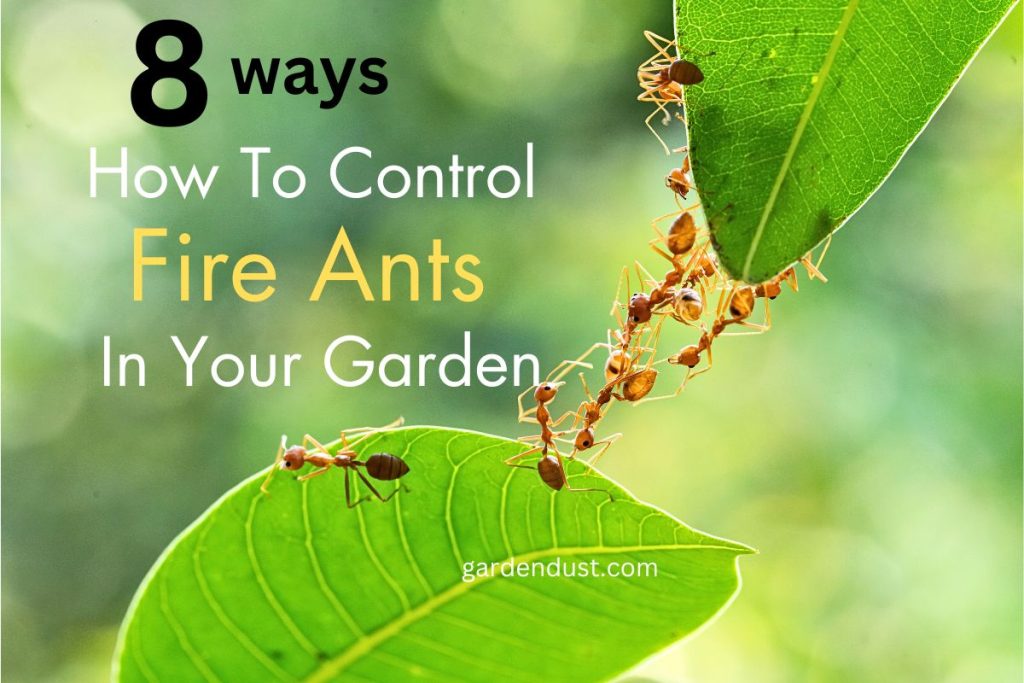Fire ants, with their painful stings and aggressive nature, can quickly turn your garden into a battleground. These invasive pests are notorious for damaging plants, affecting soil quality, and posing a threat to both humans and pets. However, with the right strategies, you can regain control of your garden and keep fire ants at bay. In this comprehensive guide, we’ll explore various methods of how to control fire ants in your garden. Let’s begin…
How To Control Fire Ants In Your Garden-8 ways
Before diving into control methods, it’s essential to understand the biology and behavior of fire ants. Fire ants belong to the Solenopsis genus and are known for their reddish-brown coloration and painful stings. They construct large, dome-shaped mounds in soil, making their nests easily identifiable. Fire ants are highly social insects with a complex caste system that includes workers, queens, and males.
1. Natural Predators and Biological Controls
One of the most eco-friendly ways to control fire ants is by introducing natural predators and biological controls into your garden. Nematodes, microscopic roundworms, can be applied to the soil to infect and kill fire ant larvae. Additionally, certain species of birds, such as the red imported fire ant’s natural predator, the phorid fly, can help keep fire ant populations in check.
2. Boiling Water
An effective and cost-efficient method to eliminate fire ant mounds is by pouring boiling water directly onto the nest. This method works best during the cooler parts of the day, as ants are closer to the surface. Take caution not to burn yourself, and repeat the process as needed to ensure complete eradication.
3. Diatomaceous Earth
Diatomaceous earth is a natural, abrasive powder that can be sprinkled around fire ant mounds. This substance dehydrates and damages the ants’ exoskeletons, ultimately leading to their demise. Be sure to choose food-grade diatomaceous earth to avoid harmful additives.
READ ALSO:-HOW TO GET RID OF JUNE BUGS: 5 EASY METHODS
4. Beneficial Nematodes
Beneficial nematodes, microscopic organisms that parasitize and kill insects, can be an effective biological control for fire ants. Apply nematodes to the soil surrounding the ant mounds, following the package instructions for optimal results. This method is safe for plants and pets.
5. Homemade Ant Bait
Create a homemade bait by combining borax with a sweet substance like sugar or syrup. Place the mixture near fire ant mounds, and worker ants will carry it back to the colony, where it will be ingested by the entire population. Borax disrupts their digestive system and proves fatal over time.
6. Commercial Ant Baits
Various commercial ant baits are available, containing insecticides that specifically target fire ants. These baits come in granular or liquid form and are designed to be attractive to the ants. Follow the product instructions carefully and place the bait near the mounds for effective control.
7. Insecticidal Dusts
Insecticidal dusts, such as those containing pyrethroids or carbaryl, can be applied directly to fire ant mounds. These dusts work by disrupting the ants’ nervous system, leading to paralysis and death. Use caution when applying insecticidal dusts, and follow the safety guidelines provided on the product.
8. Repeating the Process
Regardless of the chosen control method, it’s crucial to monitor your garden regularly and address new fire ant mounds promptly. Fire ants are resilient, and a proactive approach is key to maintaining control over their populations.
Fire ants can wreak havoc on your garden, but with a strategic and multi-faceted approach, you can effectively control and eliminate these troublesome pests. Whether you opt for natural predators, DIY solutions, or commercial products, consistency is crucial in preventing fire ant reinfestations. By understanding their behavior and employing a combination of methods, you can reclaim your garden and create a safe, pest-free environment for both plants and people. Happy Gardening…







